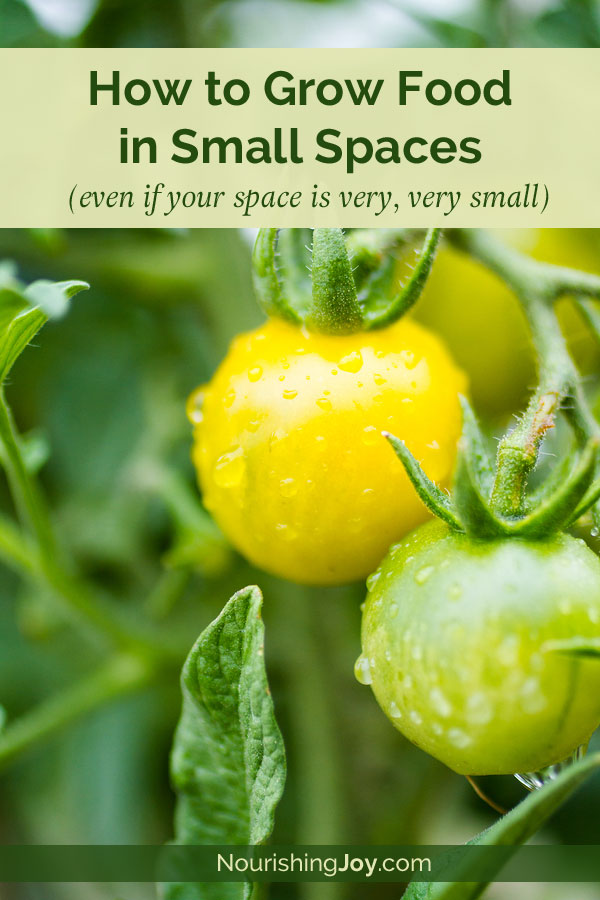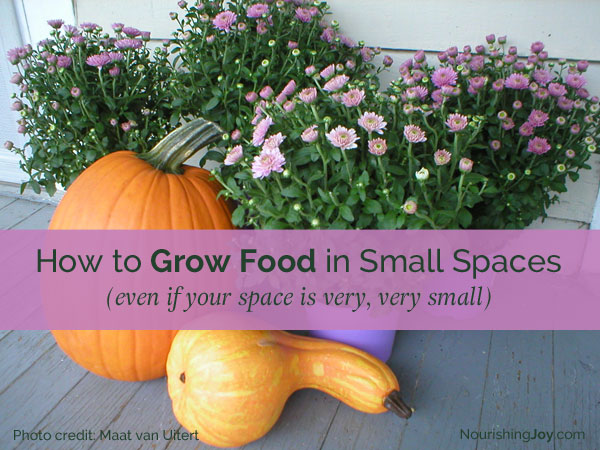How to Grow Food in Small Spaces: 8 Tips That Work (Even if Your Space is Very, Very Small)
This post may contain affiliate links, including those from Amazon.com, which means we earn a small commission off your purchases. And here's the thing: We only mention services and products that we think are truly worth your attention, whether they're free, paid, or otherwise. This site relies on YOUR trust, so if we don't stand behind a product 110%, it's not mentioned. Period.
If there's one thing I know about, it's trying to garden in small spaces. I lived for 10 years in a less-than-idea location: a north-facing condo on the 4th floor with a small balcony. I was still able to have a small harvest of tomatoes, herbs, cucumbers, zucchini, and even raspberries.
There ARE advantages to growing in small spaces. Better soil control and pest control are two traditional garden headaches small-area gardeners can avoid. You get to avoid the trauma of waking up to find out a hungry rabbit made dinner of all your pea shoots!
Over the years, I became something of a small-space-garden connoisseur, and I'm sharing those tips with you today.
1. Vertical Gardening
If you can't grow out, consider growing up. Vertical gardening is an answer to small space gardening. Use trellises to grow cucumbers and squash, you can even grow melons vertically!
You can make a trellis out of almost anything, but bamboo was my favorite because it is flexible but still attractive.
On my balcony, I trained my cucumbers to grow on the rails, so I always had a lot of pollinator action, and my cukes grew well.
I also took advantage of hanging planters, and when it got cold, I was even able to bring cherry tomato plants indoors to extend my growing season. I was able to grow 4-5 cherry tomato plants every year!
2. Container gardening
Container gardening is an obvious choice for small spaces, and you'll have a good advantage. You can control moisture and soil content better than a traditional gardener.
You're limited by your imagination with container gardening – you can grow pretty much anything. This year, even though I have about 10 acres of land, I'm growing potatoes in a container.
I can better control the soil and pests, and I don't have to dig up a lot of land to grow! I've made special raised beds that I will add to vertically as my potato plants grow.
If you're going to a more intensive gardening or plant several different types of plants together, be sure to avoid these common companion planting mistakes.
3. Consider plants that do well in shady areas
An advantage to growing in small spaces is you can use plants that do well in shady areas. If you trellis cucumbers vertically, you can plant, for example, lettuce in a container, and keep it shaded during the summer under the cucumber trellis.
You can have fresh lettuce during a time when traditional gardeners can't, because it's too hot, and their garden is in full sun. You can also grow herbs in shady areas! Parsley, mint, and oregano do well in the shade.
4. Don't be afraid to grow like a farmer
What I mean by this is to embrace the growing seasons – don't just buy tomatoes and only grow tomatoes because they grow well in small spaces. Grow seasonally – cold weather crops, cover crops, etc.
In early spring, you can grow cool weather crops, transition to warm loving crops like tomatoes and squash, and then transition back to cooler weather crops in the fall. In winter, you can grow grains or a nitrogen-fixing cover crop.
If you have a 20′ x 50′ plot you're not sure what to do with, consider growing your own grains. You can grow almost enough wheat for a family in a surprisingly small space, and you can do it over winter. Growing wheat is easy!
You can still have 4 seasons in small spaces, each season bringing it's own advantages.
Which brings us to….
5. Improve your soil
With container gardens, in some ways more than traditional gardens, you're very dependent on the quality of your soil. Container gardening can be intensive, and your plant is dependent on you to provide nutrients it can't get otherwise.
I always reused the same soil year after year and improved it by adding compost, or making it lighter with vermiculite. Consider over crops over the winter, such as a nitrogen-fixer like red clover.
Avoid commercial plant foods and fertilizers. In my experience, they aren't as helpful as compost and compost teas, and are full of questionable ingredients. It's easy to source free compost and composted manure with a little searching.
6. Window farming
In recent years, window farming has become a popular for urban apartment dwellers who still want to have some control over their food source, but who don't have access to a balcony or a community garden.
Britta Riley of Windowfarms is a Brooklyn apartment-dweller who, along with a world-wide community, developed a method to farm hydroponically in her very-urban home.
Their method is simple, yet effective, and an excellent option!
7. Add color – grow edible flowers!
Consider edible plants that also add color and interest to your garden. Swiss chard is a nutritious cold weather crop you can grow right now. It comes in a rainbow of colors, and is easy to grow.
Basil grows a pretty purple flower that you can add to salads or just use as a garnish. If your season isn't long enough for squash, or if you don't want to grow squash for the gourds, you can grow it for its flowers. Squash flowers are used in dishes like Squash Flower Soup. They also make an attractive, colorful plant.
8. Substitute edible landscaping for ornamental landscaping
If your goal is to grow a garden to save money, a great way to fully utilize the space available to you is to replace your ornamental landscaping with edibles. There are many edible plants (including flowers) that are as attractive as ornamentals.
Instead of boxwoods, consider blueberry plants. If you want to add a tree to your yard for shade, plant fruiting trees. Apple trees have beautiful flowers in the spring, and are just as beautiful as ornamental cherry trees.
Growing in small spaces doesn't have to be limited or boring. Use these tips to improve your harvest, shift your thinking, and enjoy your space all year long!




I love love love gardening. I have three raised beds out back, but my problem is that there is a lot of shade off and on during the day. I do know about crop rotation